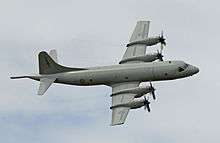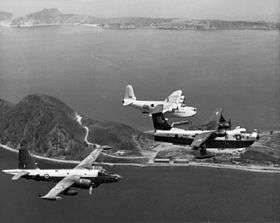No. 5 Squadron RNZAF
No. 5 Squadron RNZAF is a squadron of the Royal New Zealand Air Force formed during November 1941 in Fiji. It remains on active duty and logged 2,300 hours flight time in 2007.[2]
| No. 5 Squadron RNZAF | |
|---|---|
Squadron Insignia | |
| Active | November 1941 – November 1942 July 1944 – present |
| Country | |
| Branch | |
| Role | Anti-ship/Anti-submarine warfare, Maritime patrol, Search and rescue |
| Garrison/HQ | RNZAF Base Auckland |
| Motto(s) | Fiji: Keitou Kalawaca Na Wasaliwa (Translation: We span the ocean) |
| Colors | Black and White |
| Mascot(s) | Albatross |
| Anniversaries | 03 November |
| Equipment | 6 x P-3K2 Orions |
| Engagements | World War II Operation Enduring Freedom |
| Commanders | |
| Current commander | Wing Commander Glen "GD" Donaldson |
| Insignia | |
| Squadron Badge | In front of a blue roundel, an Albatross volant facing sinister with its wings spread in flight |
| Squadron Codes | OT (Nov 1941 – Nov 1942)[1] PA (Jul 1944 – 1945)[1] KN (1946–1955)[1] |
History
World War II
Initially, the Squadron was equipped with Vickers Vincents. From the outbreak of hostilities with Japan, the Squadron operated the Short Singapore Mk.IIIs (transferred in October 1941 from No. 205 Squadron RAF) mainly on maritime patrol and anti-submarine duties, rescuing more than fifty survivors of ditched aircraft[3] and successfully attacking a Japanese submarine in the process with the elderly Singapores. These types were superseded by Consolidated PBY Catalinas, which aided the air-sea rescue capability. The Squadron moved from Fiji in late 1944 to operate between Espiritu Santo and the Admiralty Islands. During this time the later conqueror of Mount Everest, Edmund Hillary, served with the Squadron.[4] In November 1944, the Squadron moved to Luganville Seaplane Base on Espiritu Santo to carry out anti-submarine patrols and escort duty[5] In August 1945, the Squadron was withdrawn to Fiji.[6]
Cold war
Following the war, the Squadron was re-equipped with 16 Short Sunderland MR.5s and based at Laucala Bay, in the suburbs of Suva, Fiji, tasked with maritime surveillance "over the vast South Pacific Ocean, medical evacuation flights, and communications flights for the colonial administrators." From 1965, the Squadron relocated to Whenuapai, Auckland, to re-equip with five Lockheed P-3B Orions in the anti-submarine role. The Squadron withdrew its last flight of Sunderlands from Laucala Bay in 1967.
The P-3B fleet was upgraded in the mid 1980s (Project Rigel) with a more modern radar (APS-134), an IRDS camera, a digital computing bus, and electronic displays/information management system. They were subsequently redesignated P-3K. A sixth aircraft was purchased from the RAAF during the Project Rigel upgrade.
No. 5 Squadron won the Fincastle Trophy for anti-submarine work on a number of occasions, although in recent years the focus has shifted from anti-submarine warfare to broader maritime patrol and search and rescue missions.
Twenty-first century

The aircraft have been deployed to assist international efforts on several occasions. From May 2003 to February 2004, a detachment operated in support of Operation Enduring Freedom by patrolling the Arabian Sea and Gulf of Oman.
In October 2004, a contract was signed with L-3 Communications Integrated Systems, of the United States, to upgrade the aircraft’s communication, navigation and surveillance, and data management systems.[7] The contract also included an upgrade of crew training, software testing and integration facilities, and mission preparation and analysis systems.
In 2005, the first of the six P-3K Orions began being upgraded to the new P-3K2 standard, modernising the avionics and mission systems.
In January 2006, No. 5 Squadron conducted trials to prove the aircraft could operate from Antarctica. This would improve capabilities to better police illegal fishing, and the trial occurred at a time when New Zealand was under pressure to intervene in the increasingly heated dispute between Greenpeace, Sea Shepherd Conservation Society, and Japanese commercial whaling ships.
In 2006, an Orion was used to photograph Raoul Island after a small volcanic eruption killed a Department of Conservation (DOC) worker.
On the 2 May 2011, the RNZAF accepted the first upgraded P-3K2 Orion from the Ministry of Defence. The aircraft is due to undergo a period of Operational Testing and Evaluation (OT&E) before commencing active use.
Following the disappearance of Malaysian Airlines flight MH-370 in March 2014, an RNZAF P-3K2 Orion was deployed to RAAF Base Butterworth to assist with the search for the Boeing 777. The Orion aircraft and crew was then re-tasked and conducted their operations from RAAF Base Pearce near Perth, Western Australia, searching the Southern Indian Ocean for MH-370 alongside other international aircraft and crews.
As of March 2015, all six RNZAF P-3K2 Orions are fully operational after their comprehensive upgrades.[8]
In December 2015 the final aircraft and crew rotation returned from a 16 month operation deployed to the Middle East. The deployment supported Combined Maritime Forces in maritime security, anti-terrorism, anti-narcotics, and anti-piracy operations. The detachment completed over 170 missions and flew over 1400 hours.[9]
The category five Tropical Cyclone Winston caused widespread damage to Fiji in February 2016. A RNZAF P-3K2 Orion was launched and conducted reconnaissance flights less than 24 hours after the cyclone had devastated the archipelago. The imagery captured from the P-3K2 Orion was published widely to raise international awareness of the humanitarian situation. This imagery was instrumental in determining the needs of the worst-hit areas in hours, rather than the days usually required for traditional ground surveys.[10]
P-3K2 Orion aircraft conducted multiple surveys in 2017 of the Ambae volcano, located in the Vanuatu archipelago, following increasing levels of volcanic activity. This information was used to assist the Vanuatu National Disaster Management Office in preparation for major volcanic eruptions.[11]
A P-3K2 Orion was deployed to the Pacific in January 2018 following the sinking of the MV Butiraoi, a Kiribati ferry carrying over fifty passengers. Seven survivors were located drifting in a dinghy, and their rescue was coordinated by the P-3K2 crew.[12] In the seven years from 2010-2017, P-3K2 search and rescue operations have saved 119 lives, rescued 92 people, and assisted 67 people.[13]
In February 2018 the final aircraft and crew rotation returned from a further deployment to the Middle East. Over the course of the deployment 135 missions and over 1000 hours were flown supporting Combined Maritime Forces. The deployment worked towards improving maritime security in the region, preventing piracy, and narcotics and weapons smuggling. During the deployment information provided by the P-3K2 Orion led to the seizure of over $700 million of heroin.[14]
A P-3K2 Orion and crew were deployed to Japan in September 2018 to help implement United Nations Security Council resolutions against North Korea. The P-3K2 flew alongside international partners to detect maritime activity that contravened UN sanctions, in particular, ship-to-ship transfers.[15]
Replacement for Orions
In April 2017 it was revealed that the New Zealand Government was considering buying four Boeing P-8A Poseidon maritime patrol aircraft from the United States to replace the Orions.[16] On 9 July 2018 the government confirmed the purchase, with the Poseidon to be delivered and operational by 2023, requiring relocation of the squadron to RNZAF Base Ohakea.
Photo gallery
 The Short Singapore III flying boat.
The Short Singapore III flying boat.- No. 5 Sqn Consolidated Catalinas.
- A No. 5 Sqn Catalina in the immediate post war period.

- An ex-No. 5 Sqn Sunderland at New Zealand's Museum of Transport and Technology (MoTaT).
 No. 5 Sqn P-3Bs during a 1982 exercise with USN and RAAF units.
No. 5 Sqn P-3Bs during a 1982 exercise with USN and RAAF units.
References
- Notes
- Flintham and Thomas 2003, p. 141.
- Mateparae, Jerry (8 September 2008). "Can't fight? In fact we still punch above our weight". www.nzherald.co.nz. The New Zealand Herald. Retrieved 25 March 2011.
- Darby 1978, p. 20.
- "Sir Edmund Hillary". Air Force News (89). New Zealand Defence Force. February 2008. Retrieved 10 July 2015.
- Ross 1955, p. 277
- Ross 1955, p.314
- "P3 Systems Upgrade [Ministry of Defence NZ]". Defence.govt.nz. 2013-06-21. Retrieved 2013-10-22.
- Royal New Zealand Air Force (2 May 2011). "Air Force welcomes upgraded P-3K2 Orion" (Press release). Archived from the original on 6 February 2013. Retrieved 10 July 2015.
- "NZDF Orion Completes 16 Month Operation Middle East". New Zealand Defence Force. New Zealand Defence Force. Retrieved 5 October 2019.
- "NZDF Orion Helped Fiji Secure Foreign Aid for Cyclone Response". New Zealand Defence Force. New Zealand Defence Force. Retrieved 5 October 2019.
- "NZDF Plane to Assess Erupting Volcano in Vanuatu". New Zealand Defence Force. New Zealand Defence Force. Retrieved 5 October 2019.
- "NZDF - NZDF Finds Survivors from Missing Kiribati Ferry". nzdf.mil.nz. Retrieved 2019-10-06.
- "NZDIA NZSAR Presentation for release.pdf". fyi.org.nz. Retrieved 2019-10-06.
- "Minister of Defence Commends NZDF Personnel for Middle East Work". New Zealand Defence Force. New Zealand Defence Force. Retrieved 5 October 2019.
- "New Zealand, Australia sending aircraft to help implement UN North Korea sanctions". Stuff.co.nz. 7 September 2018. Retrieved 5 October 2019.
- "New Zealand considers purchasing new Boeing military aircraft from US". stuff.co.nz (Press release). 29 April 2017. Retrieved 29 April 2017.
- Bibliography
- Darby, Charles (1978). RNZAF: The First Decade, 1937–46. Dandenong, Victoria: Kookaburra Technical Publications. ISBN 0-85880-031-4.
- Flintham, Vic; Thomas, Andrew (2003). Combat Codes: A Full Explanation and Listing of British, Commonwealth and Allied Air Force Unit COdes Since 1938. Shrewsbury, Shropshire, UK: Airlife Publishing. ISBN 1-84037-281-8.
- Ross, John (1955). Royal New Zealand Air Force. Historical Publications Branch. ISBN 0898391873.
Further reading
- Harrison, Paul (2006). Kiwi Orions. Paraparaumu, New Zealand: Kiwi Air Research. ISBN 9780473113612.
External links
- RNZAF Web site 5 Squadron page
- Culpan, Pete. "5 Squadron RNZAF Association". www.5sqnassn.org.nz. 5 Squadron RNZAF Association. Retrieved 25 March 2011.